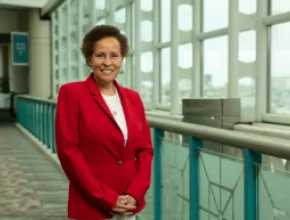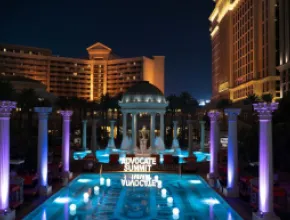Native American casino development continues at breakneck speed throughout the West, ensuring a steady stream of dazzling new meetings and entertainment options.
Two new major casino resorts are being built in the Phoenix area, and southern Arizona now has its first casino hotel. Washington’s hive of casino construction activity includes two large projects opening in metro Seattle later this year. New Mexico will unveil its largest casino resort complex this year, and Oregon has opened its first new casino hotel in a decade.
The big Indian gaming news, however, comes from California. Easily the country’s top Native American gaming state in revenue, it has more than 50 casinos, about one-third of which include hotels and meeting space.
California
Golden State gaming expansion received a boost when voters in February’s Super Tuesday election approved Propositions 94 through 97 in what has been described as one of the state’s most expensive ballot fights.
The approval allows four Southern California tribes to collectively add up to 17,000 slot machines in exchange for increasing payments to state coffers. Previously, like all tribes, each was limited to 2,000 slots under the first agreements (called compacts) signed with the state in 1999 and 2000, the days of budget surpluses.
The amended compacts, which are valid through 2030, were approved by state legislators last June, but opponents, including labor unions and other tribes, were able to get the issue on the ballot.
The four tribes are the Agua Caliente Band of Cahuilla Indians of Palm Springs, the Morongo Band of Mission Indians of Banning (Riverside County), the Pechanga Band of Luiseño Indians of Temecula (Riverside County) and the Sycuan Band of the Kumeyaay Nation of El Cajon (San Diego County).
The Pechanga and Morongo, each allowed up to 7,500 more slots, and the Agua Caliente, up to 3,000 more, began installing 300 to 400 machines at their casinos; the Sycuan, allowed up to 3,000 more, has said it will add 1,000 more machines.
“Growth will happen, and the transition is already happening. But it will take some time for them to roll out expansions,” says Alan Meister, a vice president and economist with the Analyst Group in Los Angeles.
In his annual Indian Gaming Industry Report issued last June, Meister found that, with the supply constraints, California casino revenue growth slowed in 2006 but that it was not a saturated market.
“If you look at it year by year, revenue for each slot machine continues to increase—a sign that the peak has not been reached,” he says.
Early this year, Meister issued a study for a coalition supporting the propositions. It showed that their statewide fiscal and economic benefits would total $16 billion over the life of the amended compacts. Of the amount, $10.2 billion would go to the state’s general fund; other amounts would go to state and local taxes, and revenue sharing with local governments and non-gaming tribes.
In addition to the recent slots expansion go-ahead, California has plenty of hot spots for casino resort and meeting facility expansion.
A major example is Palm Springs and the Coachella Valley. The Agua Caliente Band operates two casinos in the area, each with 1,000 slots.
Nancy Conrad, tribal spokesperson, says that 850 new slots will be installed at its Agua Caliente Casino in Rancho Mirage by mid-April. A decision on additional slots at its Spa Resort Casino in downtown Palm Springs has not yet been made, but “we are looking at how best to utilize the space.”
Under its amended compact, in addition to being allowed 3,000 more slots, the tribe may build a third casino.
In April, the tribe will open a $300 million, 344-room hotel with a spa and 13,000 square feet of meeting space adjacent to its Agua Caliente Casino; in October, it will unveil a new 2,000-seat entertainment venue.
It is also in the early days of planning a new 420-room hotel to replace its 288-room hotel at Spa Resort Casino.
In Coachella, the Twenty-Nine Palms Band of Mission Indians operates the 1,500-slot Spotlight 29 Casino. It intends to open a second casino, the 350-slot Nuwu Casino, and a campground early next year. A 125-room hotel, a 1,000-seat amphitheater and a golf course are planned for a second phase.
In Indio, the 250-room Fantasy Springs Resort Casino, which boasts a 100,000-square-foot events center, opened the Eagle Falls Golf Course last year.
West of Palm Springs in Cabazon, the Morongo Band of Mission Indians operates the 3-year-old, 310-room Morongo Casino Resort & Spa, which has meeting space that includes a 12,000-square-foot ballroom.
The Temecula area, with six casinos, is California’s most concentrated tribal gaming area and is also seeing expansion.
Accounting for a combined total of more than 80,000 square feet of meeting and event space, the area boasts the 507-room Pala Casino Resort & Spa in Pala, the 653-room Harrah’s Rincon Casino and Resort in Valley Center and the 522-room Pechanga Resort and Casino in Temecula, which will open an 18-hole championship golf course this summer.
Also in Valley Center, the 1,750-slot Valley View Casino has spent $114 million on a multiyear expansion project. In December, it unveiled a new 350-seat buffet. A 2,000-seat concert venue opens this month, and a boutique hotel is planned.
The newest and smallest facility, the 349-slot Santa Isabel Casino, opened in April last year near Lake Henshaw with a 50-seat buffet and an entertainment stage.
Off I-15, in Pauma, the Pauma Band of Mission Indians operates a 1,280-slot casino. Last August, the tribe announced, in partnership with Pequots Foxwoods Development Co., that it plans to replace the facility with a $300 million resort featuring a 500-room hotel and a 2,000-slot casino.
Fifty miles north of Temecula in the San Bernardino area is the 2,000-slot San Manuel Indian Bingo & Casino in Highland, which can handle 4,000 people for special events. The San Manuel Band of Mission Indians is building San Manuel Village, a 12-acre office and retail project that includes a 110-room Hampton Inn & Suites.
East of San Diego off I-8, the Viejas Band of Kumeyaay Indians operates Viejas Casino and a bingo hall and an adjacent outlet center. Last August, the tribe announced plans for an $800 million resort that is to include a second casino, a hotel and conference space slated for a 2012 completion.
Within 30 minutes of downtown San Diego are two notable meetings properties: the 400-room Barona Valley Ranch Resort & Casino with golf and more than 100,000 square feet of meeting space, and the 103-room Sycuan Resort & Casino with 54 holes of golf and group space for up to 200 people. Barona’s golf course was named the fourth-best course last year in Golf Digest’s list of the country’s top 40 casino courses.
Elsewhere in the state, the San Joaquin Valley is home to the Tachi Palace Hotel & Casino in Lemoore, which added 255 rooms and 6,000 square feet of meeting space in fall 2006.
There have been several major California casino expansion announcements in recent months.
In the Sacramento area, the 200-room Cache Creek Casino Resort, which has 5,000 square feet of meeting space, has unveiled plans for a 467-room hotel and conference center addition.
Thunder Valley Casino, which is completing an environmental impact study, revealed plans for a 650-room resort with 30,000 square feet of meeting space and a 3,000-seat theater.
The Dry Creek Rancheria Band of Pomo Indians announced plans to build a $300 million casino resort in Geyserville in Sonoma County. It will replace its existing River Rock Casino and include a 260-room hotel, spa and meeting space.
Washington
The Evergreen State has almost 30 tribal casinos.
The Seattle area will get 30,000 square feet of additional meeting space and a 370-room hotel when the Tulalip Tribes open a $125 million expansion this summer in Marysville.
Located between the 2,000-slot Tulalip Casino and the tribe’s 100-store Seattle Premium Outlets, the project includes a 15,000-square-foot ballroom. The casino already has a 2,300-seat amphitheater.
Set to open in the fourth quarter, 27 miles east of Seattle, is Casino Snoqualmie. The Snoqualmie Tribe secured $330 million in financing for the project, which will include a 1,650-slot casino, a 1,000-seat events center and a 200-seat nightclub.
Casinos have added hotel rooms and meeting space in the past few years.
In fall 2006, at the Clearwater Casino Resort Hotel & Spa on Puget Sound, the Suquamish Tribe opened an 85-room hotel with meeting space accommodating 120 people for banquets; and in Ferndale, north of Bellingham, the Lummi Nation unveiled the 105-room Silver Reef Hotel & Spa adjacent to its casino that includes additional meeting areas, bringing total meeting space to over 6,300 square feet.
North of Olympia, the Squaxin Island Tribe opened a 98-room hotel addition to its Little Creek Casino Resort last year, bringing its room count to 190. The resort has 11,000 square feet of meeting space.
And there have been groundbreakings.
Outside Spokane, the Kalispell Tribe operates the 1,200-slot Northern Quest Casino at Airway Heights. Last July, it broke ground on a $275 million resort, slated to open in early 2010. Components include a 350-room hotel, a new 2,000-slot casino, a 10,000-square-foot spa, and a 2,300-seat events theater.
The Confederated Tribes of the Chehalis broke ground in December on a 15,000-square-foot addition to their 50,000-square foot Lucky Eagle Casino in Rochester, which features the 69-room Lucky Eagle Hotel with meeting facilities for up to 80 people. To be completed this fall, the expansion includes a new events center, a bingo hall, a 300-seat buffet, and six new function rooms.
Also, in a joint venture with Great Wolf Resorts, the Chehalis will open the $100 million, 389-room Great Wolf Resort on tribal land this spring. It will feature a spa, waterpark, and a 40,000-square-foot conference center.
The Stillaguamish Tribe has a $44 million expansion under way at its Angel of the Winds Casino in Arlington, north of Seattle, that will triple its size by year’s end. The number of slots will increase from 535 to 1,000, and there will be a new restaurant and entertainment lounge.
In the Tacoma area, the Puyallup Tribe operates two casinos off I-5—the 2,000-slot Emerald Queen Casino and the 140-room Emerald Queen Casino Hotel. In December, the casino hotel expanded its gaming area, doubling its number of slots to 1,500, and later this year will open a new buffet and upscale restaurant.
Among other casino resorts are the 103-room Skagit Valley Casino Resort in Bow and the 150-room waterfront Quinault Beach Resort and Casino in Ocean Shores, which is surrounded by more than 200 acres of protected wetlands and sits on a pristine stretch of beach.
Operated by the Upper Skagit Tribe, Skagit Valley features a 650-slot casino, 4,000 square feet of meeting space and a 450-seat showroom. The Quinault Indian Nation’s resort offers 16,090 square feet of meeting space and can accommodate up to 900 people.
Oregon
The Beaver State has just nine tribal casinos, but seven of them now have hotels and meeting space.
In December, the new $56 million Three Rivers Casino & Hotel debuted on the coast in Florence. It is the state’s first new casino since Confederated Tribes of the Coos, Lower Umpqua and the Siuslaw opened a temporary casino there three years ago. It offers a 650-slot casino with table games four times the size of the temporary facility, a 93-room hotel, five new restaurants, and an 8,500-square-foot multipurpose events center.
Inland in Willamina, 65 miles southwest of Portland, the Confederated Tribes of Grand Ronde are building a complex that will include an events and entertainment center and additional conference space. It is adjacent to their 254-room Spirit Mountain Casino, which has 5,000 square feet of meeting space.
The 100-room Wildhorse Resort & Casino in Pendleton, which has golf and 18,000 square feet of meeting space, completed a $15 million expansion in May last year. It added four new F&B operations, including a cabaret venue also available for events, an adjacent lounge and two new restaurants, and a new non-smoking gaming area with 140 new machines, bringing its total number of slots to over 800.
Other casino resorts include Lincoln City’s oceanfront 308-room Chinook Winds Casino with 35,000 square feet of meeting space; in Coos Bay, the 112-room Mill Casino Hotel with 12,000 square feet; in Canyonville, the 147-room Seven Feathers Hotel & Casino with 22,000 square feet; and in Warm Springs, the 139-room Kah-Nee-Ta High Desert Resort and Casino with 15,000 square feet.
Arizona
The Grand Canyon State has more than 20 casinos.
The newest casino hotel is the Desert Diamond Casino near Tucson International Airport, which opened in November.
Promoted as southern Arizona’s first casino hotel, the Tohono O’odham Gaming Enterprise’s $100 million facility features a 150-room hotel, 8,000-square feet of meeting and event space, a new 500-seat bingo hall, and a new casino three times larger than the former Desert Diamond Casino, now the site of a parking lot.
Near Scottsdale, the Salt River Pima-Maricopa Indian Community has begun work on Casino Arizona Resort & Spa, with an expected January 2010 opening. It will feature a 497-room hotel, a spa, 100,000 square feet of indoor and outdoor meeting space that will include a 24,000-square-foot ballroom, and a 240,000-square-foot gaming and entertainment venue. The tribe currently operates two other Casino Arizonas in the Scottsdale area.
Near Phoenix, the Gila River Indian Community broke ground in November on its new $200 million casino resort off I-10, slated for a May 2009 opening. Called the Wild Horse Pass Casino & Hotel it will include a 100,000-square-foot casino plus a 241-room hotel with a ballroom and conference facilities, and a 1,200-seat entertainment venue.
The tribe operates three casinos on its 600-square-mile reservation. The new project will replace the existing Wild Horse Pass Casino a mile away, which is close to its 500-room Sheraton Wild Horse Pass Hotel—a major meetings property with 100,000 square feet of function space and two 18-hole golf courses.
Earlier, the tribe broke ground on a new casino to replace its Lone Butte Casino near Chandler.
In Fountain Hills near Scottsdale, the 240-room Radisson Fort McDowell Resort & Casino, opened in November 2005, delivers 25,000 square feet of indoor meeting space, including an 18,000-square-foot ballroom. The Yavapai tribe, which owns the hotel, opened a second 18-hole championship golf course, the Saguaro, in December 2006.
Other Arizona meetings options include the 146-room Harrah’s Phoenix Ak-Chin in Maricosa, which offers four meeting rooms, the largest of which is 4,800 square feet; the 80-room Cliff Castle Casino in Camp Verde, north of Phoenix, which houses a 3,500-seat entertainment pavilion and a six-room conference facility; the 128-room Hon-Dah Resort Casino & Conference Center in Pinetop in the White Mountains with six meeting rooms, the largest seating 700 theater style; and the Apache Gold Casino Resort in San Carlos with a 146-room Best Western hotel, an 18-hole golf course and a conference facility seating up to 400 theater style.
New Mexico
New Mexico has 15 casinos and a major new property in the pipeline.
The 390-room Hilton Santa Fe Buffalo Thunder Resort is scheduled to open by the end of the year 12 miles north of Santa Fe in the Pueblo of Pojoaque, offering a spa, 66,000 square feet of meeting space and entertainment venues.
The new Buffalo Thunder Resort will be integrated with the Pueblo of Pojoaque’s existing facilities, which include an 18-hole golf course and two hotels, the 124-room Cities of Gold with 6,600 square feet of meeting space, and an 81-suite Homewood Suites.
In Albuquerque, the state’s newest casino, the 228-room Sandia Resort and Casino, opened December 2005 and features more than 50,000 square feet of meeting space, a 1,700-slot casino and a Scott Miller-designed golf course.
Thirteen miles south of Albuquerque, the Pueblo of Isleta is nearing completion of an expansion that includes a 201-room hotel with 30,000 square feet of conference and banquet space. The Isleta Casino & Resort currently includes a 1,600-slot casino, 12,000 square feet of function space and 27 holes of golf.
The Santa Ana Pueblo Reservation, 15 minutes north of Albuquerque, is home to the Santa Ana Star Casino and the 350-room Hyatt Regency Tamaya Resort & Spa with 20,000 square feet of meeting space and an 18-hole golf course. Last year the Hyatt added the House of the Hummingbird, a 12,000-square-foot open-air ballroom in a garden setting.
Near Ruidoso, the Mescalero Apache-owned Inn of the Mountain Gods Resort & Casino features a 1,000-slot casino, a 273-room hotel with 40,000 square feet of meeting space and a Ted Robinson-designed championship course.
Other States
Several other states have casino properties that stand out.
Idaho has the 196-room Coeur d’Alene Casino Resort Hotel in Worley, 30 minutes from Spokane, with 12,000 square feet of conference space and 18 holes of golf. Its golf course tied with Barona for fourth-best casino course in Golf Digest’s top 40 casino-course list.
Montana has the Best Western KwaTaqNuk Resort in Polson with a casino and meeting and space that can accommodate up to 300 people for banquets.
Nevada’s three Indian casinos include the Fort Mojave Tribe’s 455-room Avi Resort and Casino in Laughlin, with a golf course and an 11,000-square-foot meeting center.






